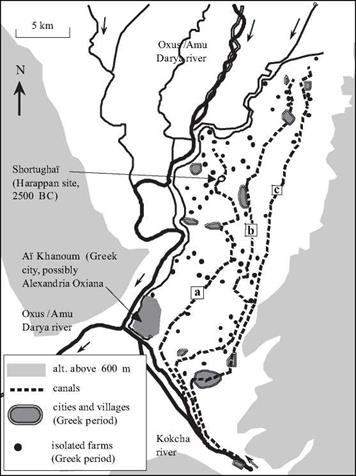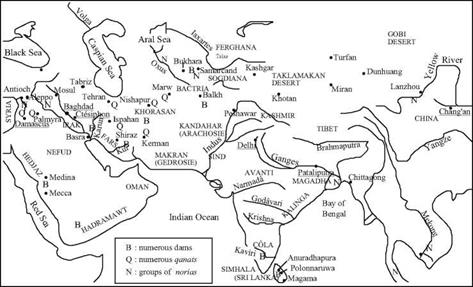Beyond Rome, The East And The Arab World
Beyond the Roman Empire – Persia and India
Between the Tigris, the Ganges, and the Oxus: multicultural influences
The Indus valley had harbored the great “hydraulic” civilization of Harappa between the third and second millenia BC. This civilization would develop to have exchanges with the Mesopotamian millenia, and had extended its influence along the “lapis-lazuli route”, to the north of the Hindu Kush mountains in Bactria (Figures 1.3, 7.1). After the collapse of this civilization only the trading posts to the south remained, at and around the mouth of the Indus at Lothal. Development later continues in the Bactria – a prosperous civilization grows on the banks of the Oxus and its tributaries, a civilization that uses gravity canal irrigation in the cultivation of terraces overlooking the rivers (Figure 7.2).
The ancient Indian civilization grew from Indo-European (Aryan) migration from the northwest in the middle of the IInd millennium BC. The earliest Vedic texts, written in Sanskrit around the 6th century BC, give us our earliest distinct portrait of the development of this civilization. The birth of Buddha is placed in this century at about 560 BC.
After the fall of the Persian Empire and the death of Alexander, all of the region from Mesopotamia to the borders of India becomes the domain of Seleucos, one of Alexander’s generals, and then of his descendents the Seleucids. In India itself the Maurya Dynasty, 313 to 180 BC, includes a period of unification from the Ganges to the Indus under the grand sovereign Afoka (about 269 to 232 BC). The development of writing first appeared in his reign, as did the humanistic principles inspired by Buddhism. Only the extreme south of India and Ceylon (modern-day Sri Lanka) are not included in this unification.
Around 250 BC the Parthians from the north of Iran push the Seleucids back toward Syria and settle in Mesopotamia. In so doing, they isolate Bactria and Sogdiana from the rest of the Hellenistic world. This is the beginning of the Greek kingdom of Bactria, destined to spread Hellenistic culture toward India. Around 200 BC, Bactria’s king Euthydemus and his son Demetrius set out to conquer large regions of India. These Indo-Greeks were subsequently pushed back out of Bactria by a people who are known to us through Chinese history as the Yuehzi. The Chinese, pushed to the north by the Xiongnu (fellow nomads of unsavory reputation and who were likely the ancestors of those whom we now call the Huns), try to form alliances with the Yuehzi. In the 1st century BC, the Yuehzi found the empire of the Kuchans, occupying all the high valleys of the Ganges and the Indus up until the 2nd century AD. The stability of the great empires across these centuries – Rome to the west, the Parthians and the Kuchans in Asia, the Chinese empire of the Han Dynasty to the east – favors development of the Silk Road.
Meanwhile in Ceylon there are many signs of active commerce with Roman merchants.
The power of the Arabs rises in the near east during this time. In 640 AD the Arabs take Alexandria, occupying Egypt and destroying the Sassanide Persian Empire that had supplanted the Parthians from the 4th century BC. Having been confined to the Indus for a long time, the Arabs occupy Sind as well as Samarcand in 712, and in 751 they affront the Chinese armies on the Talas River to the northeast of Samarcand, in the loop of the Iaxartes (today the Syrdarya). This was an Arab victory in principle, but in reality it marked the end of their expansion toward the east. With the decline of authority of the caliphs of Baghdad, the Ghaznavid Turks become the masters of Persia at the end of the 10th century AD. India collapses under their blows around 1000 AD, and all the north of the country is pillaged. Then successive waves of Mongols sack Mesopotamia in 1258 AD, and continue to ravage the north of India as far as Delhi in 1398 AD. Turkish-Mongol regimes control the sultanate of Delhi from the 13th century AD, and control the entire northern half of India until the 17th century, including the Ganges and Indus valleys.
|
Figure 7.1 From the Syrian coast to the heart of China, in the ancient and medieval eras. Cities whose names are underlined are the great capitals: Ctesiphon for the Sassanide Persians, Balkh (Baktria) for the Greek kingdom of Bactria, Damascus and Baghdad for the Ummeyyades and the Abbassids, Pataliputra (Patna) for the India of the Mauryans and the Guptas, Delhi for the Turkish sultanate that dominates the north of India in the XIIIth century, Chang’an for China of the Han and Tang dynasties. |
Figure 7.2 Irrigation of the plain of АЇ Khanoun in eastern Bactria, at the confluence of the Oxus (Amou Daria) and the Kokcha. АЇ Khanoun was probably the Alexandria of the Oxus. The map shows the population patterns and the traces of the principal irrigation canals during the time of the Greek kingdom of Bactria. These principal canals rise from the Kokcha and run along the plateau toward the north. The Oxus flows in an adjacent lower course, 20 m below the irrigated plain, which is why its water could not be used. After 37 centuries of irrigation using this same basic layout of canals, the plain returns to desert after the Mongol invasions of the 13th century AD (Francfort, 1989; Gentelle, 1989; Gardin, 1998). For an overview map, see Figure 1.3.
a.  Canal trace dating from the Bronze Age (IIIrd millennium BC) passing by the Harapan site of Shortughai. It supported irrigation of 6,000 hectares of barley, wheat, lentils, and sesame.
Canal trace dating from the Bronze Age (IIIrd millennium BC) passing by the Harapan site of Shortughai. It supported irrigation of 6,000 hectares of barley, wheat, lentils, and sesame.
b. Canal developed before or during the time of the Persian Empire (Figure 2.20)
c. New canal built in the time of the Greek kingdom of Bactria. It brings the irrigated area to
16,0 hectares. It is abandoned, and then restored with the same general alignment during the Islamic period.







Leave a reply